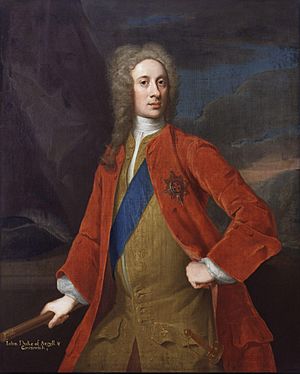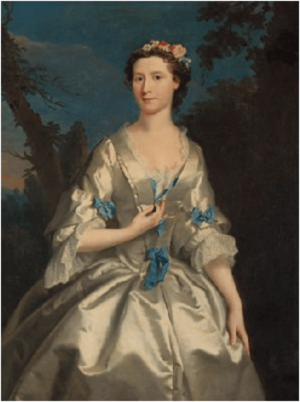John Campbell, 2nd Duke of Argyll facts for kids
Quick facts for kids
The Duke of Argyll and Greenwich
|
|
|---|---|

Portrait by William Aikman
|
|
| Predecessor | Archibald Campbell, 1st Duke of Argyll |
| Successor | Archibald Campbell, 3rd Duke of Argyll |
| Other names | Iain Ruaidh nan Cath or Red John of the Battles |
| Born | 10 October 1680 Ham House, Petersham, Surrey |
| Died | 4 October 1743 (aged 62) Sudbrook Park, Petersham |
| Buried | Westminster Abbey |
| Wars and battles | Nine Years' War War of the Spanish Succession Jacobite rebellion of 1715 |
| Spouse(s) | Mary Brown Jane Warburton |
| Issue | 4 daughters, including Caroline and Mary |
| Parents | Archibald Campbell, 1st Duke of Argyll Elizabeth Tollemache |
John Campbell, the 2nd Duke of Argyll and 1st Duke of Greenwich, was a very important Scottish nobleman and a top commander in the British Army. He was born on October 10, 1680. He fought in several major wars across Europe, including the Nine Years' War and the War of the Spanish Succession.
He became famous for leading the government army against the Jacobites during the Jacobite Rebellion. He also held important government jobs, like Lord Steward and Master-General of the Ordnance. He was known by the nickname "Red John of the Battles" because of his military skills.
Contents
Early Life and Family
John Campbell was born at Ham House in Surrey. His father was Archibald Campbell, 1st Duke of Argyll. His mother was Elizabeth Campbell. When John was five, his grandfather, Archibald Campbell, 9th Earl of Argyll, led a rebellion against King James II. Sadly, his grandfather was executed for this.
John was taught at home by different tutors as he grew up.
Starting His Military Career
John began his military career when he was quite young. In 1694, he became a colonel in a regiment (a military unit) that his own family had put together. He served briefly in Europe during the Nine Years' War. This war involved many European countries.
Later, he fought under the famous Duke of Marlborough in the War of the Spanish Succession. This was a big war about who would rule Spain. John fought in the Battle of Kaiserwerth in 1702. That same year, he was made a Knight of the Order of the Thistle, which is a special honor.
Leading in Big Wars
In 1703, John became the Duke of Argyll after his father passed away. This also made him the leader of Clan Campbell, a powerful Scottish family. He was also made a privy councillor, meaning he advised the King or Queen.
He helped convince the Parliament of Scotland to support the Act of Union. This act joined Scotland and England to form Great Britain. Because of his help, Queen Anne made him the Earl of Greenwich and Baron Chatham in 1705.
John continued to fight in the War of the Spanish Succession. He was promoted to major-general in 1706. He led troops in important battles like the Battle of Ramillies and the Siege of Ostend. He also fought at the Battle of Oudenarde and the Siege of Lille. By 1709, he was a lieutenant general and took part in the Siege of Tournai and the Battle of Malplaquet.
In 1710, he received another high honor, becoming a Knight of the Order of the Garter. The next year, he was promoted to full general and took charge of all British forces in Spain. He successfully helped British troops leave Spain. After this, he became the Commander-in-Chief, Scotland, leading all British forces in Scotland.
The Jacobite Uprising
In 1715, a major rebellion started in Scotland. This was the Jacobite Rebellion. The Jacobites wanted to bring back the old royal family to the throne. John Campbell led the government army against the Jacobites, who were led by the Earl of Mar.
They met at the Battle of Sheriffmuir in November 1715. The battle didn't have a clear winner, but it helped the government's side in the long run. John then led his army to capture Perth, which was the Jacobite capital. He took the city with very little fighting.
Later Life and Legacy
After the Jacobite uprising, John Campbell returned to London. He held several important positions in the government. He became Lord Steward of the Household in 1721. This role meant he managed the royal household. Later, in 1725, he became Master-General of the Ordnance. This job involved managing the army's weapons and supplies.
In the 1720s, he had a beautiful house built for himself called Sudbrook Park. It was designed by a famous architect named James Gibbs.
On January 31, 1735, John Campbell was promoted to field marshal, the highest rank in the British Army. He passed away on October 4, 1743, at Sudbrook Park. He was buried in Westminster Abbey, a very important church in London where many famous people are laid to rest. A large monument was built there to honor him.
Argyll Street in London's West End is named after him, showing his lasting impact.
Family Life
John Campbell was married twice. His first wife was Mary Brown, whom he married in 1701. They separated not long after. After Mary passed away in 1717, he married Jane Warburton in the same year. Jane was a maid of honor to Queen Anne.
John and Jane had four daughters who grew up: Caroline, Lady Elizabeth Campbell, Lady Anne Campbell, and Lady Mary Coke.



